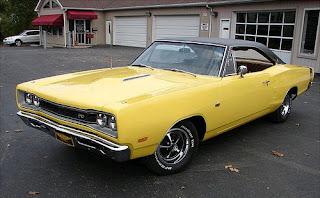'69 Coronet Interior (4-speed)
The interior of the Super Bee borrowed the race car–inspired and more sophisticated gauge and speedometer dash cluster from the Dodge Charger while the four-speed cars received an actual Hurst Competition-Plus shifter with Hurst linkage, compared to the budget-minded Road Runner's less expensive Inland shifter and linkage. All these niceties added to the higher purchase price of the Super Bee compared to its Plymouth cousin, and ultimately affected its sales numbers over the years it was produced. Read more...
426 Hemi
The Super Bee, like nearly all Chrysler "muscle cars" of that era, was available with the 426 Hemi engine, however this option raised the price by 33% and only 125 were sold.
Read more...
440 Six-Pack
 A "six-pack" (three 2bbl carburetors) version of Dodge's 440 engine was a Super Bee option.
A "six-pack" (three 2bbl carburetors) version of Dodge's 440 engine was a Super Bee option.NOTE: The 440 Magnum (4bbl) was not an available option for the Super bee, and was reserved for the Coronet R/T. Read more...
Dodge Super Bee vs R/T

The rear lights and logos were the only difference (bodywise) between the Coronet R/T and Super Bee.
NOTE: The Coronet 500 and R/T have the same tail lights.
'68 Superbee vs '69 Superbee
 The only differences (bodywise) between the 68-69 Coronets is the tail lights, side turn lights, and front grill.
The only differences (bodywise) between the 68-69 Coronets is the tail lights, side turn lights, and front grill.
The 1968 Super Bee only had two engine options, the base 383 Magnum, and the 426 Hemi.
The 1969 Super Bee had three engines to choose from - the base 383 hp (high performance), 440 Six Pack, and the 426 Hemi.
Subscribe to:
Comments (Atom)































